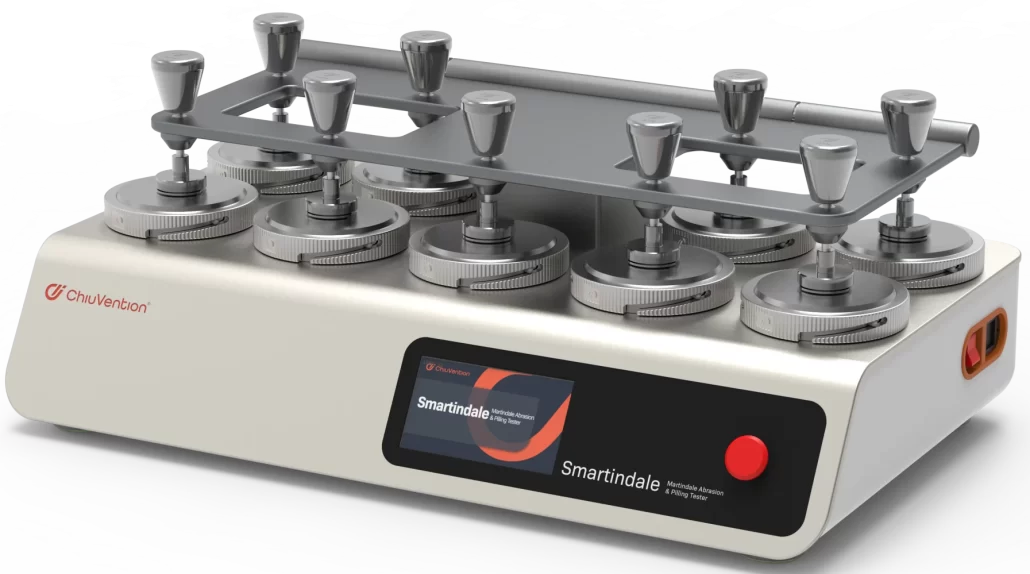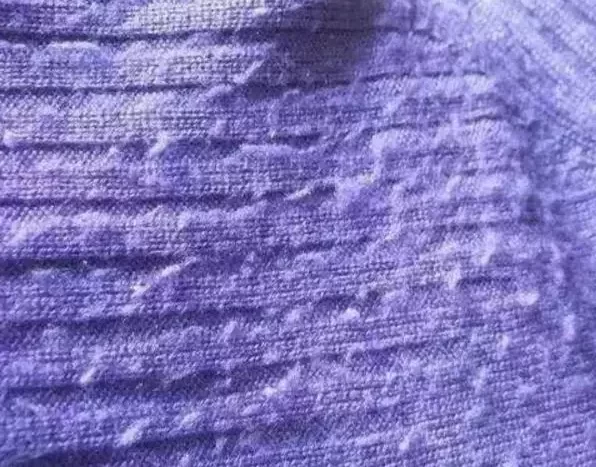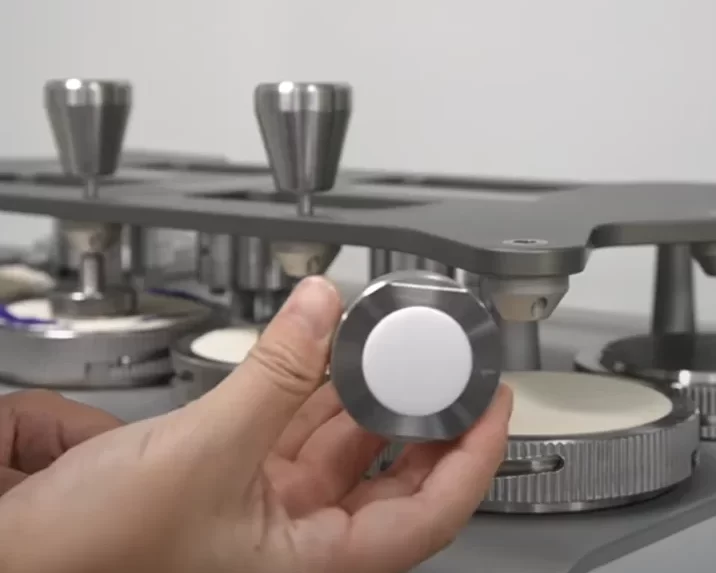ISO 12947-2 Martindale Abrasion Pilling Test Purpose and Scope
The ISO 12947-2 Martindale test checks fabrics for abrasion and pilling resistance.
The ISO 12947-2 standard gives a method to test fabrics for abrasion and pilling. It is for the Martindale Abrasion Pilling Test. This test method applies to many fabrics, including cotton, wool, and synthetics. The test checks fabric durability. It simulates the abrasion conditions the fabrics will face in actual use. A motor drives the test equipment (Martindale Abrasion Tester). It connects to a disc that drives a weighted friction device. This device moves back and forth on a specimen, causing it to pill or abrade. The test checks the specimen’s resistance to pilling and abrasion under pressure.
The tests use standard friction cloths and felts. The process completes under specified temperature and humidity conditions. The test results can guide material selection and assess the fabric’s grade. This, in turn, helps design and produce the product. Also, the test requires strict control of sample placement and the test environment. This ensures the accuracy and repeatability of the results. The ISO 12947-2 Martindale Abrasion Pilling Test is a series of standardised operations. It provides a scientific, reliable way to test fabric performance.
Which fabrics is the ISO 12947-2 Martindale Abrasion Pilling Test applicable to?
The ISO 12947-2 Martindale Abrasion Pilling Test applies to:
woven and knitted fabrics
nonwovens
upholstery
coated fabrics
It can test a wide range of fabrics.
The ISO 12947-2 Martindale Abrasion Pilling Test is for many types of fabrics, including:
Woven fabrics: Textiles made of interwoven warp and weft. They are stable and durable.
Knitted fabrics: Textiles made by looping yarns with knitting needles. They have good elasticity and breathability.
Manufacturers bond or sew fibers to make non-woven fabrics. They don’t need a spinning process. They are lightweight and very malleable.
We use decorative materials to beautify the environment. They include wallpaper and curtains. They must be durable and aesthetic.
Coated fabrics: Textiles with a coating on the surface. They are waterproof and stain-resistant.
These fabrics are widely used in daily life and industrial applications. The ISO 12947-2 Martindale Abrasion Pilling Test Standard is key. It helps evaluate these fabrics’ quality and performance. They must keep their appearance and performance during use.
ISO 12947-2 Martindale Abrasion Pilling Test Methods
ISO 12947-2 is a test method for textiles. It assesses their abrasion resistance and pilling. The method tests textiles for abrasion resistance and pilling. It simulates the friction from actual use. The test subjects the specimen to low-pressure, continuous friction with a certain material. You can then compare it to standard parameters to evaluate its abrasion and pilling. This test method tests the abrasion resistance and pilling of some fabrics. It ensures test accuracy and reliability. It is widely used in textile quality control and research.
The specific operation steps include:
Specimen prep: In the standard environment, lay the specimen flat. Leave it unstretched for a set time, e.g., 24 or 16 hours, per different standards.
Specimen selection: Cut a piece from different parts of the whole door width fabric. The specimen must be representative. For fancy fabrics, the sample must show all the different tissues and colors in the fabric.
Setting up the device: Place the felt and abrasive material on the abrasive table. Put the weight on the abrasive material. Then, add the pressure ring and tighten the nut. This will fix the abrasive material to the table.
Testing process: Place the test fixture with the specimen face down on the base fixture. Then, adjust the test fixture’s circular groove to align with the loading shaft rod. The loading shaft rod should fit into the test fixture’s circular groove. After the set number of times, start the switch and the test. Then, automatically stop.
Evaluating the results: Remove the specimen. It is then compared to a standard photo in a rating box. This checks for wear and pilling.
Also, the ISO 12947-2 Martindale Abrasion Pilling Test Method has many standards. It has many parameters, too. They ensure the tests are accurate and consistent. These standards include, but are not limited to, ISO 5470, DIN 53863/53865, and BS 3424/5690. They cover various aspects of the test. These include the number of tests, total counts, test heads, and the friction diameters of abrasive blocks. They aim to ensure that the test results are reliable and comparable.
Why choose ISO 12947-2 for Martindale Abrasion Pilling Test?
We chose ISO 12947-2 for the Martindale Abrasion Pilling Test. It is accurate and reliable. The standard is widely used and respected in textile abrasion testing.
The ISO 12947-2 standard is a test for the abrasion resistance of textiles. The International Organisation for Standardisation (ISO) developed it. It focuses on determining specimen breakage. This standard aims to provide a uniform method for testing textiles’ abrasion resistance. It ensures consistent quality between batches and productions. Extensive research and experience form the basis of the standard. It ensures the accuracy and reliability of the test results. This gives them high authority and credibility.
Also, the ISO 12947-2 standard applies beyond textiles. It tests the abrasion resistance of leather, footwear, and other materials. This shows its wide range of uses. Adopting a standard ensures consistent product quality. It meets consumer demand for it. It also gives manufacturers a clear quality control indicator.
In summary, we chose the ISO 12947-2 standard for Martindale abrasion pilling testing. It is accurate, reliable, and widely accepted in the industry. This ensures fair, objective test results and high product quality.
ISO 12947-2 Martindale Abrasion Pilling Test Sample Requirements
ISO 12947-2 Martindale Abrasion Pilling Test Sample Requirements include the following points:
Sample Prep: The test sample must rest for 18 hours. It must be on a smooth, flat surface, under standard conditions, and without tension. Use a sampler to remove 3 samples from anywhere on the cloth, at least 100mm from the edge. The samples must contain different warp and weft yarns. The diameter of each piece is 38+0.5mm.
Environmental conditions: The test samples must be at a constant temperature and humidity. The temperature is 20+2°C and the humidity is 65+5%.
Test samples: If not specified, wash or dry-clean them before sampling, based on the fabric’s end use. When sampling the fabric, stay more than 1/10th of its width from the edge. Do not take samples from wrinkled or defective areas. They may affect the test results. Use a sampler to cut a set of circular samples from the fabric without the same weft yarns between the samples.
Set up the test equipment: Mount a standard felt and a 165 mm specimen, both with a 165 mm diameter, on the abrasive table. Mount the specimen with the front side down and the standard foam on the specimen holder. Put the specimen holder on the grinding table. Then, insert the centre shaft into the holder.
These requirements ensure the tests are accurate and repeatable. They also provide reference data for material selection.
How do I set up the instrument for the ISO 12947-2 Martindale Abrasion Pilling Test?
The ISO 12947-2 Martindale Abrasion Puckering Test has four steps. They are: prepare the specimen, install the device, set the parameters, and run the test.
Preparation of the specimen:
Cut a specimen from different parts of the whole door width fabric. It should be representative. For fancy fabrics, the specimen must include all the tissues and shades in the fabric.
Before testing, humidify the specimen in a constant temperature and humidity environment.
A circular specimen of 38mm diameter is cut using a sampler.
In a standard environment, lay flat and unstretched for a time. This must meet the requirements of different standards.
Place the wool felt and friction cloth on the abrasive table. Put the weight on the abrasive material. Then, put on the pressure ring and tighten the nut. This will fix the abrasive material to the table.
Place the specimen into the base of the test fixture. If the specimen weighs less than 500g/m2, line it with a new piece of polyurethane foam.
Parameter setting:
Set parameters like revolutions and speed. They must meet the test’s requirements.
Preset the appropriate number of times to start the machine for testing.
Execution of the test:
Start the instrument. Enter the LCD screen to set the parameters, like the number of rotations and speed.
Load the sample into the fixture on the operation table. Then, load the mandrel and weights. Finally, start the rotation.
After reaching the set number of times, stop the machine. Then, remove the specimen and evaluate it against the standard sample photo in the rating box.
The above steps enable completion of the ISO 12947-2 Martindale Abrasion Pilling Test. It tests the instrument’s commissioning and test execution. Follow standard operating procedures for all steps. This ensures the test results are accurate and reliable.
ISO 12947-2 Martindale Abrasion Pilling Test Steps
The ISO 12947-2 Martindale Abrasion Pilling Test has these key steps:
Specimen preparation: In the standard environment, lay the specimen flat. Leave it unstretched for 24 hours to adapt to the standard.
Selection of specimen: Cut a piece from different parts of the whole door-width fabric. This will ensure the specimen is representative. For fancy fabrics, the sample must include all the different tissues and colors in the fabric.
Installation of the specimen: Loosen the fixing ring on the test fixture. Remove the specimen pressing piece. Then, put the specimen into the base of the test fixture. For fabrics up to 500 g/m², place a piece of polyester foam between the specimen and the metal stopper of the holder. For fabrics over 500 g/m², or for composite fabrics, it is not necessary to use foam. This is to ensure the same tension on each specimen holder.
To install the wool felt and friction cloth: Place the felt and abrasive on the abrasive table. Then, put the weight on the abrasive material. Next, add the pressure ring and tighten the nut. This will fix the abrasive material to the table.
Test: Attach the abrasive head to the abrasive material and pressurize it. Place the test fixture with the specimen face down on the base fixture. Adjust the test fixture’s circular groove to align with the loading shaft rod. The loading shaft rod should fit into the test fixture’s circular groove. After the set number of times, start the switch. Then, start the test. It should stop automatically after reaching the set number of times.
Evaluation of results: Remove the specimen and compare it to a standard photo in a rating box. This tests for abrasion resistance and pilling.
These steps ensure the test’s accuracy and repeatability. They are a reliable measure of the material’s abrasion resistance and pilling.
Accuracy and bias of the ISO 12947-2 Martindale abrasion and pilling test
The ISO 12947-2 Martindale Abrasion Pilling Test’s accuracy and deviation mainly depend on:
The calibration of the test equipment.
The control of the test environment.
The standardisation of the test operations.
The preparation and handling of the test samples.
Calibration of test equipment: Calibrate the Martindale Abrasion and Pilling Tester per the manufacturer’s instructions. This is to ensure accurate test results. Calibrate the equipment frequently. This ensures stable, consistent test conditions.
Control of the test environment: Tests should be at 20±2°C and 65±5% humidity. This minimizes the impact of the environment on test results.
Test operation must follow ISO 12947-2. The operator must use friction cloth and wool felt correctly. They must set the number of test times, and install the test samples correctly. This ensures the test is reproducible and comparable.
Test samples should be pre-treated in a standard environment. Then, different standards require leaving them for a certain amount of time. Cut the samples from different parts of the whole-width door fabric. They must be representative to avoid test bias from improper sample handling.
Also, test result deviations may come from: the test equipment’s maintenance, the operators’ skills, and unexpected issues during the tests. To ensure the accuracy of the test and reduce errors, we recommend: 1. Regularly maintain and calibrate the test equipment. 2. Improve the operators’ skills. 3. Strictly follow the standard operating procedures for the test.
Many factors affect the ISO 12947-2 Martindale test’s accuracy and bias control. These include equipment calibration, environmental control, standardized operations, and sample preparation and handling. These measures can greatly improve the test’s accuracy and reliability.
Precautions for the operation of ISO 12947-2 Martindale abrasion pilling test
When doing the ISO 12947-2 Martindale Abrasion Pilling Test, follow key steps. They ensure the test’s accuracy and reliability. Below are some of the key points:
Replacement of Friction Cloth: You can’t reuse friction cloths. Replace them after each test. After use, wearing and contaminating friction cloths is possible. This can affect the test’s accuracy. So, keeping the cloths clean and replacing them is key to ensuring test quality.
Wool Felt Usage: You can reuse wool felt. Replace the surface when it wears out or becomes dirty. Using wool felts on both sides can extend their life. But, you must keep them clean and in good condition.
Sample Preparation: Before testing, prepare samples. Remove any wrinkles or folds. This will prevent them from sliding or deforming during the test. Also, install the backing material to support the sample and protect the base.
Test Parameter Setting: Set the test parameters, such as load, cycles, and speed, as required. Adjust these parameters based on the fabric type and test purpose. This will ensure accurate test results.
Testing must include close monitoring of the samples. Record any signs of damage or wear in a timely manner. This helps to detect abnormalities in time and ensure the reliability of the test data.
Post-test data analysis: After the test, analyze the data. This includes measuring sample weight loss (wear) and pilling. Use the data to test the samples for abrasion and pilling. This will judge their performance.
Instrument Cleaning and Maintenance: Clean the instrument regularly. This includes the cork liner and lab tubes. This ensures they work well. Also, check the control panel buttons and screws in each part. This is to ensure the instrument’s accuracy and safety.
These precautions will ensure the ISO 12947-2 Martindale test is accurate. They will also support product quality assessment.
What are the benefits of the ISO 12947-2 Martindale test? How does it compare to other standards?
The ISO 12947-2 Martindale Abrasion Pilling Test has advantages over other standards:
Wide scope of application: ISO 12947-2 tests fabrics for abrasion and pilling. It meets the needs of different fabric types.
Standardised test methods: The standard provides a test method. It ensures the accuracy and comparability of test results. This helps improve product quality.
Ease of operation: The Martindale Abrasion Tester has a movable specimen fastening assembly. It allows for quick, independent testing of specimens. It also ensures accurate measurement of friction over the same time period. This makes the testing process more efficient and accurate.
There are various models to choose from. The instrument can provide 4, 6, or 8 head models to suit different sizes and needs of the test environment.
The timer, counter, holder, and load device meet global test standards. This ensures that the test results are internationally recognised.
Multiple evaluation methods: They assess fabrics’ abrasion and pilling resistance. They check for specimen breakage, quality loss, and appearance changes.
In short, ISO 12947-2 tests for abrasion and pilling in textiles. It is a standard, efficient, and thorough method to assess textile quality. It is a key tool for textile quality inspection and supervision.
How can I verify the results of the ISO 12947-2 Martindale Abrasion Pilling Test?
To validate the ISO 12947-2 Martindale Abrasion Pilling Test, we used: data analysis, troubleshooting, and retests.
Data analysis:
Wear test: The test measures the weight loss of the specimen. The difference is the amount of wear. To calculate the wear rate, divide the amount of wear by the duration of the test and the applied load.
Pilling Test: A sample’s tendency to pill, measured by counting the pills on its surface after the test. Pilling counts are usually performed on a scale of 1 to 5, where 5 indicates the most severe pilling.
Statistical Analysis: We must use stats to check the test results. They must be accurate. This includes finding the mean, standard deviation, and CV for multiple tests. It also includes regressions to study the link between test parameters and results.
Troubleshooting:
If test results are inaccurate, try these steps: Check the sample preparation. Verify that the test parameters were set correctly. Check the instrument calibration and adjust it if needed. Finally, retest with a new sample to ensure accuracy.
Repeat the test:
If the initial test results are inaccurate, repeat the test to verify them. Repeat testing should ensure that all conditions are consistent with the initial test. This includes sample preparation, test parameters, and instrument calibration. It will yield comparable results.
The above methods can effectively verify the results of ISO 12947-2. This ensures the Martindale Abrasion Pilling Test data is accurate.
Why validate the results of the ISO 12947-2 Martindale test?
The ISO 12947-2 Martindale Abrasion Puckering Test requires validating its results. This is vital for assessing a material’s abrasion resistance. The process of validating test results involves several key steps:
Test conditions involve conducting tests at specific temperature, humidity, and pressure levels. This ensures the accuracy and reliability of the results. These conditions directly affect the test results. To ensure repeatability and consistency, we must control them.
Specimen Preparation: Prepare the specimen to the specified size and shape. You must also clean and dry it. The specimen prep process affects the test results. Therefore, you must follow a standardized method.
Test procedure: It usually includes steps like mounting the specimen, setting the test series, and the friction number. Standardizing these steps will help. It will ensure the test runs smoothly and gives reliable results.
Data analysis: After testing, we must collect and analyze data. It will assess the specimen’s wear resistance. This process requires specialized knowledge and techniques. They ensure the data is accurate and reliable.
Standards to follow: Martindale abrasion test standards may vary by product and use. So, when doing Martindale abrasion tests, follow the relevant national and industry standards. This will ensure the test results are accurate and reliable.
The above steps will ensure the Martindale Abrasion Pilling Test is accurate. They will provide a reliable basis for selecting and using materials.
For more information on textile testing methods/standards
or textile testing machines, contact us:
What’s App: +86 180 2511 4082
Tel: +86 769 2329 4842
Fax: +86 769 2329 4860
Email: medium@chiuvention.com





